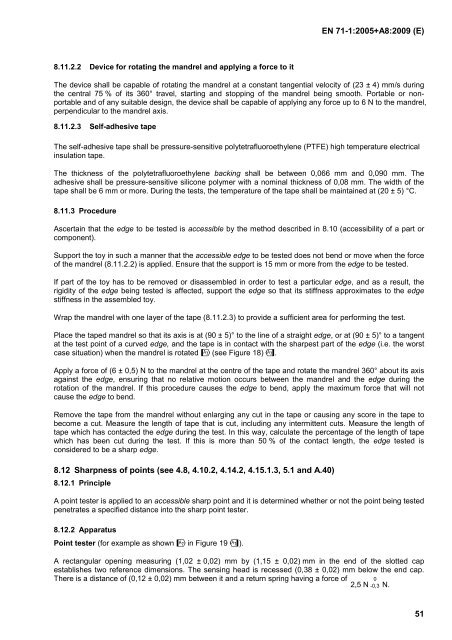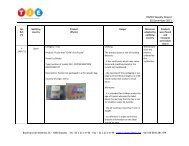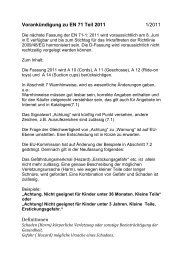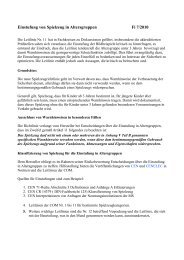Create successful ePaper yourself
Turn your PDF publications into a flip-book with our unique Google optimized e-Paper software.
8.11.2.2 Device for rotating the mandrel and applying a force to it<br />
<strong>EN</strong> <strong>71</strong>-1:<strong>2005+</strong><strong>A8</strong>:2009 (E)<br />
The device shall be capable of rotating the mandrel at a constant tangential velocity of (23 ± 4) mm/s during<br />
the central 75 % of its 360° travel, starting and stopping of the mandrel being smooth. Portable or nonportable<br />
and of any suitable design, the device shall be capable of applying any force up to 6 N to the mandrel,<br />
perpendicular to the mandrel axis.<br />
8.11.2.3 Self-adhesive tape<br />
The self-adhesive tape shall be pressure-sensitive polytetrafluoroethylene (PTFE) high temperature electrical<br />
insulation tape.<br />
The thickness of the polytetrafluoroethylene backing shall be between 0,066 mm and 0,090 mm. The<br />
adhesive shall be pressure-sensitive silicone polymer with a nominal thickness of 0,08 mm. The width of the<br />
tape shall be 6 mm or more. During the tests, the temperature of the tape shall be maintained at (20 ± 5) °C.<br />
8.11.3 Procedure<br />
Ascertain that the edge to be tested is accessible by the method described in 8.10 (accessibility of a part or<br />
component).<br />
Support the toy in such a manner that the accessible edge to be tested does not bend or move when the force<br />
of the mandrel (8.11.2.2) is applied. Ensure that the support is 15 mm or more from the edge to be tested.<br />
If part of the toy has to be removed or disassembled in order to test a particular edge, and as a result, the<br />
rigidity of the edge being tested is affected, support the edge so that its stiffness approximates to the edge<br />
stiffness in the assembled toy.<br />
Wrap the mandrel with one layer of the tape (8.11.2.3) to provide a sufficient area for performing the test.<br />
Place the taped mandrel so that its axis is at (90 ± 5)° to the line of a straight edge, or at (90 ± 5)° to a tangent<br />
at the test point of a curved edge, and the tape is in contact with the sharpest part of the edge (i.e. the worst<br />
case situation) when the mandrel is rotated -(see Figure 18)..<br />
Apply a force of (6 ± 0,5) N to the mandrel at the centre of the tape and rotate the mandrel 360° about its axis<br />
against the edge, ensuring that no relative motion occurs between the mandrel and the edge during the<br />
rotation of the mandrel. If this procedure causes the edge to bend, apply the maximum force that will not<br />
cause the edge to bend.<br />
Remove the tape from the mandrel without enlarging any cut in the tape or causing any score in the tape to<br />
become a cut. Measure the length of tape that is cut, including any intermittent cuts. Measure the length of<br />
tape which has contacted the edge during the test. In this way, calculate the percentage of the length of tape<br />
which has been cut during the test. If this is more than 50 % of the contact length, the edge tested is<br />
considered to be a sharp edge.<br />
8.12 Sharpness of points (see 4.8, 4.10.2, 4.14.2, 4.15.1.3, 5.1 and A.40)<br />
8.12.1 Principle<br />
A point tester is applied to an accessible sharp point and it is determined whether or not the point being tested<br />
penetrates a specified distance into the sharp point tester.<br />
8.12.2 Apparatus<br />
Point tester (for example as shown -in Figure 19.).<br />
A rectangular opening measuring (1,02 ± 0,02) mm by (1,15 ± 0,02) mm in the end of the slotted cap<br />
establishes two reference dimensions. The sensing head is recessed (0,38 ± 0,02) mm below the end cap.<br />
There is a distance of (0,12 ± 0,02) mm between it and a return spring having a force of 0<br />
2,5 N -0,3 N.<br />
51








